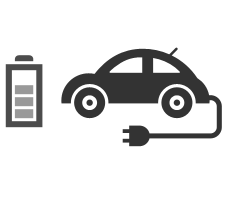Electrification
Electrification

As countries around the world strengthen environmental regulations on automobiles and promote electrification, manufacturers of finished automobiles are changing their strategies and shifting to electrification has become an urgent task. Electrification requires the development of new components that are not used in conventional automobile power trains, including batteries, motors, gearboxes, inverters, etc.
Motors
Automobile drive motors are required to be compact, highly efficient, light, and quiet. To achieve the required performance, numerous developments, such as improvement of magnet materials, innovative wire winding configurations, and changes in motor structure, are in progress. The development of motors requires testing and analysis of the materials from which the motors are made, as well as observation and measurement of the motor structure. Here we introduce the evaluation items for each major component in motor development. Click the evaluation item name to view the page that introduces the evaluation equipment.
Stator: Coil
Stator: Welded Parts
Shafts
Motor Cores
Bearings
Magnets
ASSY
Materials
Gearboxes
With electrification, gearboxes are required to be lighter, more compact, and more efficient. With this change in performance requirements, it is necessary to develop new fundamental technologies, including the adoption of new materials and new processing technologies. The development and manufacture of gearboxes requires testing and analysis of the materials used in the gearbox, evaluation of the improvement in performance due to processing, evaluation of degradation, durability, and life after long-term use.
Here we introduce the evaluation items in each process, from gearbox development to production. Click the evaluation item name to view the page that introduces the evaluation equipment.
Acquisition of Base Data Used in Simulation
Process Analysis
Process Analysis: Cutting Processes
Process Analysis: Contaminant Analysis
Process Analysis: Castings, Die-Casting
Evaluation of Prototype Products
Detailed Analysis during Failure
Inverters
In response to the demand for more compact e-axles, development is in progress to directly mount inverters on the transmission or motor and reduce the number of parts by using high-density components. In the development process, it is important to take measures to dissipate heat and lessen impact and vibration. There is a demand for the internal non-destructive observation of ECUs and fatigue and durability testing of joints, etc. Here we introduce the evaluation items implemented for each major component in inverter development. Click the evaluation item name to view the page that introduces the evaluation equipment.
Devices
Boards
Lubricating Oil
Reduction of friction in drive units by using lubricating oil is an important factor for improving fuel consumption and extending the life of drive components. In the development of lubricating oils, there is a demand for evaluation of degradation, observation of the process of formation of lubricating oil films, etc.
Application
LiB (Lithium-Ion Batteries)
Lithium-ion secondary batteries enable high-voltage, high-energy density designs, so they are used in consumer electronic equipment, such as mobile telephones and laptop computers. Growing consumer interest in reducing environmental impact and improving fuel efficiency has led to the development of batteries for use in hybrid vehicles (high-voltage) and electric vehicles (EV). The performance of battery components is greatly affected by the properties of the materials used in the components, so evaluation of material properties is implemented from various aspects, such as chemical composition, structure, surface properties, strength, durability, and hardness. Also, to evaluate the safety of batteries, non-destructive observation of the battery interior, battery crushing and puncture tests, and impact tests are performed.
Applications
Related Product
FC (Fuel Cells)
Fuel cells directly convert energy obtained in the electrochemical reaction of hydrogen fuel into electrical energy. Fuel cells have high efficiency and only discharge water, so there is great interest in them for solving energy and environmental problems. However, in order for fuel cells to be widely adopted, their performance and durability must be improved and their cost reduced. Therefore, multi-faceted evaluations of fuel cells, including measurement of their physical properties, structural analysis, observation of their form, and various strength tests, are required.


